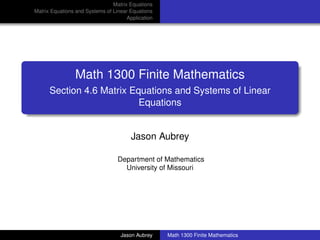
Math 1300: Section 4-6 Matrix Equations and Systems of Linear Equations
- 1. Matrix Equations Matrix Equations and Systems of Linear Equations Application Math 1300 Finite Mathematics Section 4.6 Matrix Equations and Systems of Linear Equations Jason Aubrey Department of Mathematics University of Missouri university-logo Jason Aubrey Math 1300 Finite Mathematics
- 2. Matrix Equations Matrix Equations and Systems of Linear Equations Application Solving a Matrix Equation Suppose we have an n × n matrix A and an n × 1 column matrices B and X . If A is invertible, then we can solve the equation AX = B as follows AX = B −1 A (AX ) = A−1 B multiply both sides by A−1 on the left (A−1 A)X = A−1 B matrix multiplication is associative −1 IX = A B A−1 A = I X = A−1 B university-logo Jason Aubrey Math 1300 Finite Mathematics
- 3. Matrix Equations Matrix Equations and Systems of Linear Equations Application Using Inverses to Solve Systems of Equations Example: Use matrix inverse methods to solve the system: x1 − x2 + x3 = 1 2x2 − x3 = 1 2x1 + 3x2 +0x3 = 1 First, we write this as a matrix equation: 1 −1 1 x1 1 0 2 −1 x2 = 1 2 3 0 x3 1 A X B university-logo Jason Aubrey Math 1300 Finite Mathematics
- 4. Matrix Equations Matrix Equations and Systems of Linear Equations Application So we have a matrix equation AX = B To solve this equation, we find A−1 : 1 −1 1 1 0 0 1 0 0 3 3 −1 0 2 −1 0 1 0 → · · · → 0 1 0 −2 −2 1 2 3 0 0 0 1 Row Operations 0 0 1 −4 −5 2 Therefore, 3 3 −1 A−1 = −2 −2 1 −4 −5 2 university-logo Jason Aubrey Math 1300 Finite Mathematics
- 5. Matrix Equations Matrix Equations and Systems of Linear Equations Application We know that X = A−1 B, so x1 3 3 −1 1 5 x2 = −2 −2 1 1 = −3 x3 −4 −5 2 1 −7 X A−1 B So, we conclude that x1 = 5 x2 = −3 x3 = −7 university-logo Jason Aubrey Math 1300 Finite Mathematics
- 6. Matrix Equations Matrix Equations and Systems of Linear Equations Application Using Inverse Methods to Solve Systems of Equations If the number of equations in a system equals the number of variables and the coeffiecient matrix has an inverse, then the system will always have a unique solution that can be found by using the inverse of the coefficient matrix to solve the corresponding matrix equation. Matrix Equation Solution AX = B X = A−1 B university-logo Jason Aubrey Math 1300 Finite Mathematics
- 7. Matrix Equations Matrix Equations and Systems of Linear Equations Application Insight. . . There are two cases where inverse methods will not work: Case 1. If the coefficient matrix is singular. Case 2. If the number of variables is not the same as the number of equations. In either case, use Guass-Jordan elimination. university-logo Jason Aubrey Math 1300 Finite Mathematics
- 8. Matrix Equations Matrix Equations and Systems of Linear Equations Application Example: An investment advisor currently has two types of investments available for clients: a conservative investment A that pays 10% per year and investment B of higher risk that pays 20% per year. Clients may divide their investments between the two to achieve any total return desired between 10% and 20%. However, the higher the desired return, the higher the risk. How should each client listed in the table invest to achieve the desired return? 1 2 3 k Total Investment $20,000 $50,000 $10,000 k1 Annual Return Desired $2,400 $7,500 $1,300 k2 The answer to this problem involves six quantities, two for each client. We will solve this problem for an arbitrary client k with unspecified amounts k1 for total investment and k2 for annual return. university-logo Jason Aubrey Math 1300 Finite Mathematics
- 9. Matrix Equations Matrix Equations and Systems of Linear Equations Application Let x1 = amount invested in A by a given client x2 = amount invested in B by a given client Then we have the following mathematical model: x1 + x2 = k1 total invested 0.1x1 + 0.2x2 = k2 Total annual return desired Write as a matrix equation: 1 1 x1 k = 1 0.1 0.2 x2 k2 A X B university-logo Jason Aubrey Math 1300 Finite Mathematics
- 10. Matrix Equations Matrix Equations and Systems of Linear Equations Application If A−1 exists, then X = A−1 B. So, we find A−1 : 1 1 1 0 1 0 2 −10 → ··· → 0.1 0.2 0 1 0 1 −1 10 Row Operations Thus 2 −10 A−1 = −1 10 university-logo Jason Aubrey Math 1300 Finite Mathematics
- 11. Matrix Equations Matrix Equations and Systems of Linear Equations Application Therefore, x1 2 −10 k1 = x2 −1 10 k2 X A−1 B To solve each client’s problem, we replace k1 and k2 with appropriate values from the table and multiply by A−1 : x1 2 −10 20, 000 16, 000 = = x2 −1 10 2, 400 4, 000 Client 1 Solution: x1 = $16, 000 in investment A, x2 = $4, 000 in investment B university-logo Jason Aubrey Math 1300 Finite Mathematics
- 12. Matrix Equations Matrix Equations and Systems of Linear Equations Application x1 2 −10 50, 000 25, 000 = = x2 −1 10 7, 500 25, 000 Client 2 Solution: x1 = $25, 000 in investment A, x2 = $25, 000 in investment B x1 2 −10 10, 000 7, 000 = = x2 −1 10 1, 300 3, 000 Client 2 Solution: x1 = $7, 000 in investment A, x2 = $3, 000 in investment B university-logo Jason Aubrey Math 1300 Finite Mathematics
